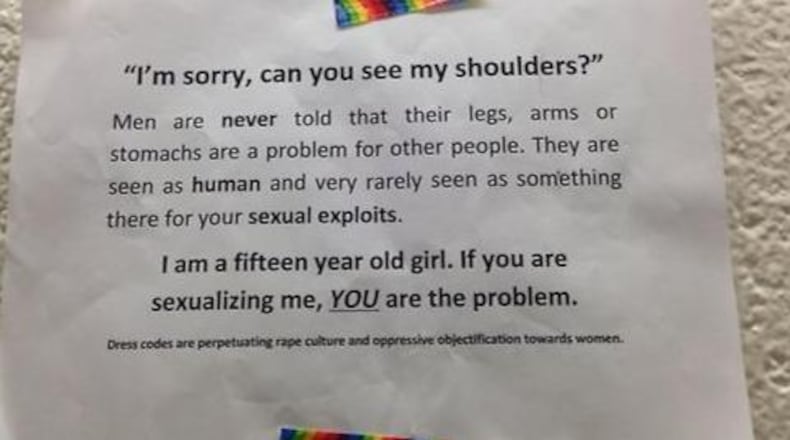Many Georgia school districts, including Atlanta Public Schools, have invested millions of dollars in social and emotional learning and equity initiatives to ensure, as APS pledges, “that every single one of our students thrives — not by accident, but by design.”
And then, in the first weeks of school, these same districts demoralize and objectify young girls by telling them their bodies must be concealed, contained and controlled.
That surveillance of girls — with the unspoken but clear subtext that spaghetti straps or exposed collarbones can distract boys — contradicts the fundamental goal of social and emotional learning to help students develop healthy identities. While schools seek to protect boys from lost learning, they routinely pull girls out of class for dress code violations.
Girls who walked confidently into school on the first day in outfits chosen for comfort — it is August in Georgia, after all — are now wearing hoodies and long pants. Why? They fear they will be singled out in the hallway for the fingertip test — where their shorts or skirts can’t fall above the fingertips. At Howard Middle School in Atlanta, girls were required to test in view of male classmates, who were spared such policing.
A Change.org petition by a student in Monroe County, Georgia, summarizes the double standard, stating: “Boys wear shorts that are 6, 7, and even 8 inches above the knee. The answer I’ve gotten is that some guys have such long legs and it’s hard for them to find shorts that aren’t below their knee and aren’t really short. Girls have long legs too, and it’s hard to find shorts the appropriate length, so girls just simply don’t wear shorts at all.”
On a recent Cobb online parent forum with more than 100 responses, a mother lamented how a male high school teacher dwelled on girls’ breasts while outlining the dress code, making her teenage daughter uncomfortable.
A mother in a suburban district told me her daughter is now trying on multiple outfits each night to avoid being coded. “She was walking into school and a male administrator commented she was ‘growing and her shorts would not be legal to wear for much longer.’ How do you think it made my adolescent daughter feel that morning to walk into school and have a male adult comment on her legs and growth pattern? It’s truly sexual harassment and discrimination that’s happening in our public schools,” said the mom.
The way we talk about bodies can have drastic and negative effects on kids and adolescents‚ said Kelly Reddy-Best, an Iowa State University professor and author of “Dress, Appearance, and Diversity in U.S. Society.”
“It is so important to be able to experiment and express yourself and see what fits. Limiting that can really damage kids,” said Reddy-Best in a telephone interview. “Allowing agency for kids to express their authentic self in whatever that means can be really powerful and make them feel more positive about their body and make them feel happier in general. Overall, the literature in the social psychology of dress says over and over that if we feel good in what we wear, we feel good about our body, ourselves and others.”
Girls are fighting back, organizing petitions, speaking at board meetings and, as Howard Middle School students did on Aug. 5, showing up at school with messages on their forearms or T-shirts declaring, “#IAmNotADistraction.”
Some schools are listening. The latest federal data shows that 43.7% of public schools enforced a strict dress code in 2019-2020, down from 56.9% a decade earlier.
Stanford Law School professor Richard Thompson Ford is an expert on civil rights and anti-discrimination law and author of the book “Dress Codes: How the Laws of Fashion Made History.”
He advises schools to toss dress codes, particularly when up to 90% of enforcement falls on girls. “You are targeting girls with the outdated idea that they’re responsible for distracting boys,” said Ford. “Frankly, my advice is drop these dress codes unless students are wearing something for which you’re concerned about their safety walking home or that violate tenets of public decency. Dress codes are just not worth the fight.”
While school administrators believe they can define sexy or erotic clothing, the history of dress demonstrates that what’s viewed as erotic changes from generation to generation and culture to culture, said Ford. “A generation ago saw a bare midriff as sexy; today’s students just don’t see it that way,” he said. “It’s not distracting to them, it’s just fashion.”
Those who shrug off dress codes as a minor infringement fail to realize the cost to girls who may have to buy new clothes and who lose instructional time when they are sent home, said Ford. And daily judgments of their bodies by adults in schools add to the insecurities that are already part of growing up.
About the Author
The Latest
Featured


